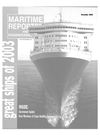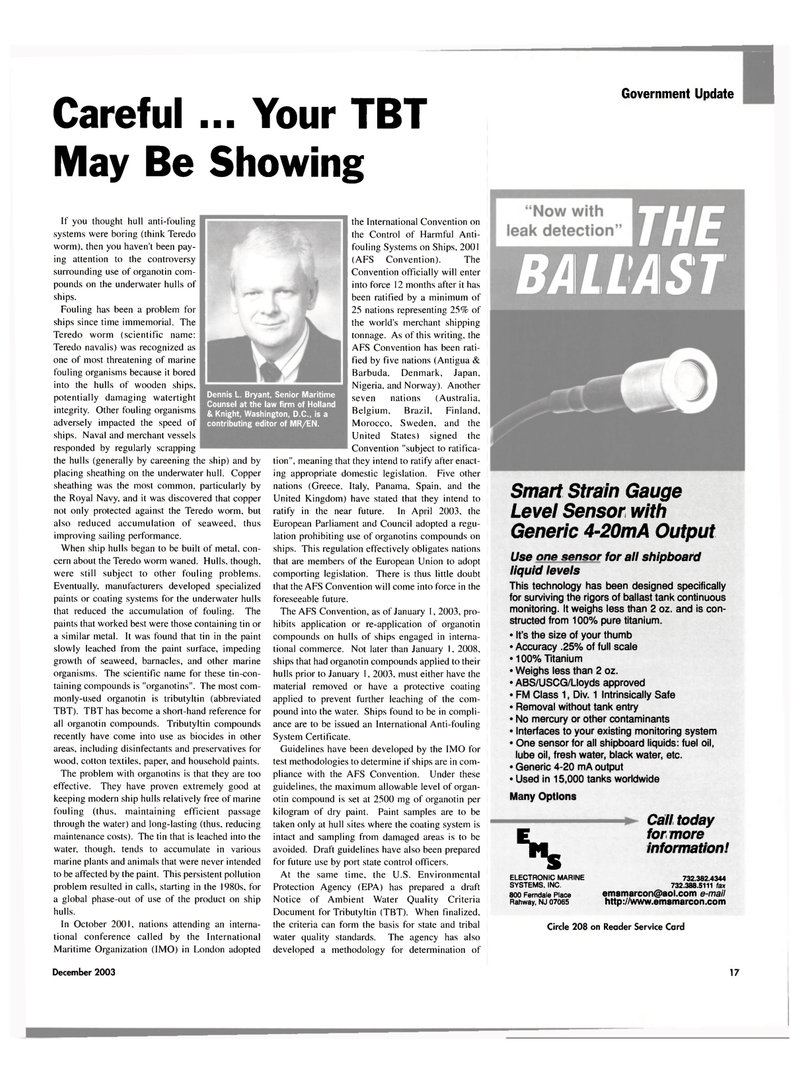
Page 19: of Maritime Reporter Magazine (December 2003)
Grear Ships of 20003
Read this page in Pdf, Flash or Html5 edition of December 2003 Maritime Reporter Magazine
Careful ... Your TBT
May Be Showing
Government Update
If you thought hull anti-fouling systems were boring (think Teredo worm), then you haven't been pay- ing attention to the controversy surrounding use of organotin com- pounds on the underwater hulls of ships.
Fouling has been a problem for ships since time immemorial. The
Teredo worm (scientific name:
Teredo navalis) was recognized as one of most threatening of marine fouling organisms because it bored into the hulls of wooden ships, potentially damaging watertight integrity. Other fouling organisms adversely impacted the speed of ships. Naval and merchant vessels responded by regularly scrapping the hulls (generally by careening the ship) and by placing sheathing on the underwater hull. Copper sheathing was the most common, particularly by the Royal Navy, and it was discovered that copper not only protected against the Teredo worm, but also reduced accumulation of seaweed, thus improving sailing performance.
When ship hulls began to be built of metal, con- cern about the Teredo worm waned. Hulls, though, were still subject to other fouling problems.
Eventually, manufacturers developed specialized paints or coating systems for the underwater hulls that reduced the accumulation of fouling. The paints that worked best were those containing tin or a similar metal. It was found that tin in the paint slowly leached from the paint surface, impeding growth of seaweed, barnacles, and other marine organisms. The scientific name for these tin-con- taining compounds is "organotins". The most com- monly-used organotin is tributyltin (abbreviated
TBT). TBT has become a short-hand reference for all organotin compounds. Tributyltin compounds recently have come into use as biocides in other areas, including disinfectants and preservatives for wood, cotton textiles, paper, and household paints.
The problem with organotins is that they are too effective. They have proven extremely good at keeping modern ship hulls relatively free of marine fouling (thus, maintaining efficient passage through the water) and long-lasting (thus, reducing maintenance costs). The tin that is leached into the water, though, tends to accumulate in various marine plants and animals that were never intended to be affected by the paint. This persistent pollution problem resulted in calls, starting in the 1980s, for a global phase-out of use of the product on ship hulls.
In October 2001, nations attending an interna- tional conference called by the International
Maritime Organization (IMO) in London adopted
Dennis L. Bryant, Senior Maritime
Counsel at the law firm of Holland & Knight, Washington, D.C., is a contributing editor of MR/EN. the International Convention on the Control of Harmful Anti- fouling Systems on Ships, 2001 (AFS Convention). The
Convention officially will enter into force 12 months after it has been ratified by a minimum of 25 nations representing 25% of the world's merchant shipping tonnage. As of this writing, the
AFS Convention has been rati- fied by five nations (Antigua &
Barbuda. Denmark, Japan,
Nigeria, and Norway). Another seven nations (Australia.
Belgium. Brazil, Finland,
Morocco, Sweden, and the
United States) signed the
Convention "subject to ratifica- tion", meaning that they intend to ratify after enact- ing appropriate domestic legislation. Five other nations (Greece, Italy, Panama, Spain, and the
United Kingdom) have stated that they intend to ratify in the near future. In April 2003, the
European Parliament and Council adopted a regu- lation prohibiting use of organotins compounds on ships. This regulation effectively obligates nations that are members of the European Union to adopt comporting legislation. There is thus little doubt that the AFS Convention will come into force in the foreseeable future.
The AFS Convention, as of January 1, 2003, pro- hibits application or re-application of organotin compounds on hulls of ships engaged in interna- tional commerce. Not later than January 1, 2008, ships that had organotin compounds applied to their hulls prior to January 1, 2003, must either have the material removed or have a protective coating applied to prevent further leaching of the com- pound into the water. Ships found to be in compli- ance are to be issued an International Anti-fouling
System Certificate.
Guidelines have been developed by the IMO for test methodologies to determine if ships are in com- pliance with the AFS Convention. Under these guidelines, the maximum allowable level of organ- otin compound is set at 2500 mg of organotin per kilogram of dry paint. Paint samples are to be taken only at hull sites where the coating system is intact and sampling from damaged areas is to be avoided. Draft guidelines have also been prepared for future use by port state control officers.
At the same time, the U.S. Environmental
Protection Agency (EPA) has prepared a draft
Notice of Ambient Water Quality Criteria
Document for Tributyltin (TBT). When finalized, the criteria can form the basis for state and tribal water quality standards. The agency has also developed a methodology for determination of
BALLAST
Smart Strain Gauge
Level Sensor with
Generic 4-20mA Output
Use one sensor for all shipboard liquid levels
This technology has been designed specifically for surviving the rigors of ballast tank continuous monitoring. It weighs less than 2 oz. and is con- structed from 100% pure titanium. • It's the size of your thumb • Accuracy .25% of full scale • 100% Titanium • Weighs less than 2 oz. • ABS/USCG/Lloyds approved • FM Class 1, Div. 1 Intrinsically Safe • Removal without tank entry • No mercury or other contaminants • Interfaces to your existing monitoring system • One sensor for all shipboard liquids: fuel oil, lube oil, fresh water, black water, etc. • Generic 4-20 mA output • Used in 15,000 tanks worldwide
Many Options
X
Call today for more information!
ELECTRONIC MARINE
SYSTEMS, INC. 800 Ferndale Place
Rahway, NJ 07065 732.382.4344 732.388.5111 fax [email protected] e-mail http ://www.emsmarcon .com
Circle 208 on Reader Service Card
December 2003 17

 18
18

 20
20
